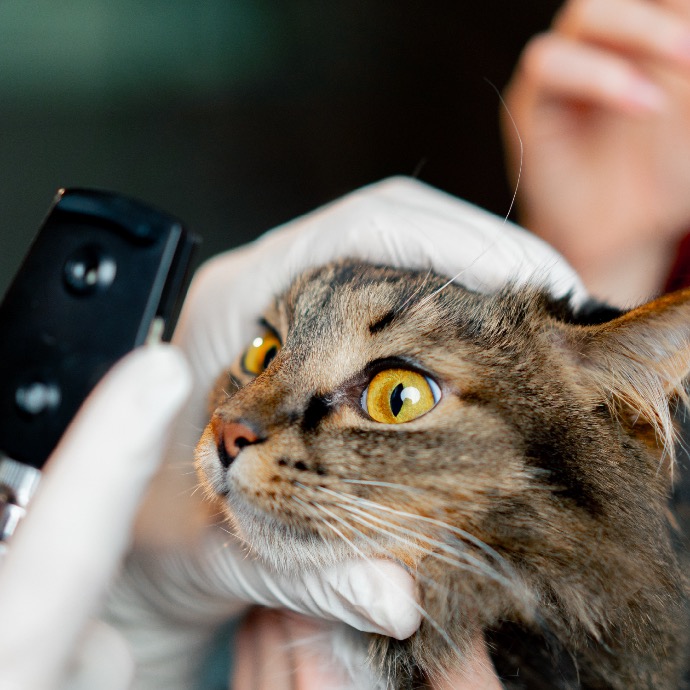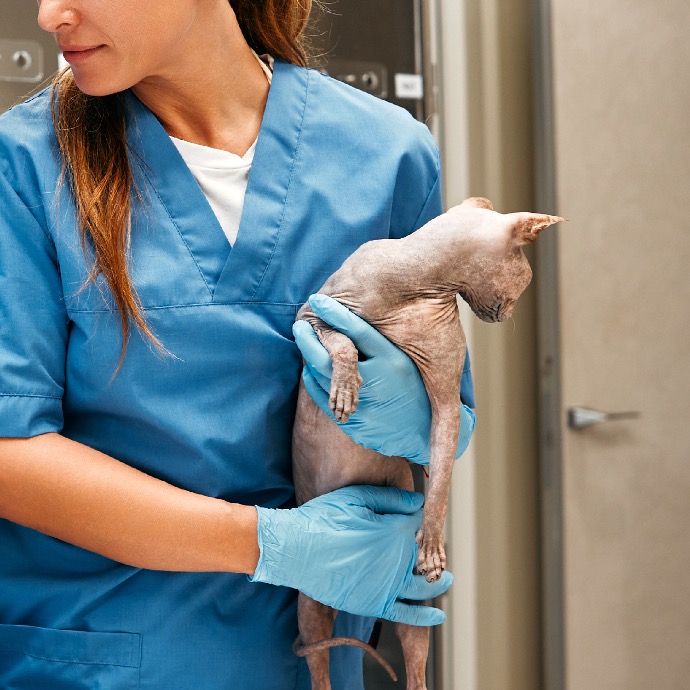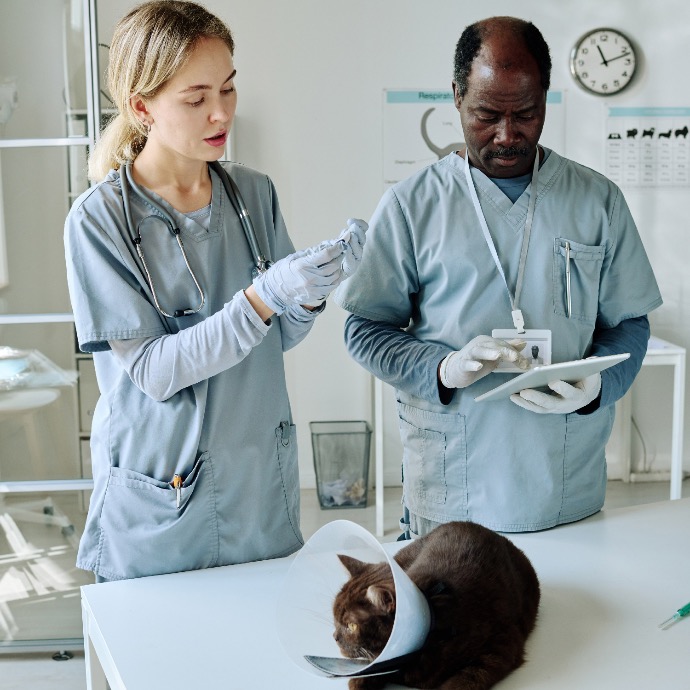Pain management is your team’s priority
September marks National Pain Awareness Month, a time dedicated to raising awareness about the widespread impact of pain, its management, and the importance of proper care. Originally established to advocate for better pain management practices in human medicine, Pain Awareness Month now serves as a reminder that pain is a critical issue in all fields of healthcare - including veterinary medicine.
For veterinary professionals, this month is an opportunity to spotlight the importance of pain management in animals, a topic that is sometimes overlooked but just as essential as in human care. In fact, pain in pets is often harder to recognize, as animals instinctively hide signs of discomfort.
According to the AAHA, this means it's hard for pet owners to identify when their furry family members are in pain, and it’s up to everyone in your practice to participate in pain management and education.
This month, refamiliarize yourself with the AAHA’s most recent guidelines on pain management to improve care, planning, and communication in your practice
IVECCS 2024 isn't just about learning and professional development—it's also about having fun and connecting with colleagues in a more relaxed setting. The conference organizers have planned a variety of social events and activities to help you unwind and enjoy your time in St. Louis.
According to the AAHA, pain management in veterinary care has evolved from being reactive to a more proactive, preemptive approach. The idea is to manage pain before it fully manifests, especially in cases of surgery or chronic conditions. Preemptive pain management aims to prevent the onset of intense pain, reducing the long-term impact on the animal's health and well-being.
The key principles of proactive pain management include:

Preemptive analgesia
Administering analgesic therapies before surgery or disease progression is most effective. For acute pain, this means administering medications before the surgical procedure. In chronic cases, the goal is to start treatment as soon as possible to slow down disease progression and avoid worsening of pain

Multimodal targeting
A combination of therapies is generally more effective than relying on a single treatment method. This approach helps prevent over-reliance on one medication, reducing the risk of side effects. Multimodal pain management might include pharmacologic therapies like NSAIDs, opioids, local anesthetics and non-pharmacologic therapies like physical therapy, cold compression, weight management, and exercise.

Early detection and intervention
Rapid detection of pain, whether acute or chronic, is crucial. Veterinary teams must assess pain early, through physical exams, pain scales, and owner input. For chronic pain, educating pet owners to monitor for subtle changes in behavior, posture, and gait at home can aid in early detection.

Client education and engagement
Pet owners must be actively engaged in monitoring their pet’s condition. Encouraging them to look for early signs of chronic pain, such as difficulty in climbing stairs, reluctance to jump, or changes in behavior, helps in managing pain earlier. This partnership between the veterinary team and the owner ensures timely intervention and ongoing management.
Practical examples of proactive management
For dogs prone to osteoarthritis (OA), starting preventive treatment in early adulthood - such as weight management and controlled exercise - can slow disease progression and reduce the severity of pain later in life.
Certain breeds, like Labradors or Great Danes, that are genetically predisposed to joint problems benefit from early interventions, such as preemptive use of analgesics and lifestyle adjustments, to minimize pain associated with conditions like hip dysplasia.
Assessment tools for pain in dogs and cats
Recognizing pain in animals is challenging, especially since pets instinctively hide discomfort. To effectively manage pain, veterinary professionals must rely on a range of assessment tools that integrate physical exams, behavioral observations, and owner feedback.

Physical examination
This remains the foundation of pain assessment. Veterinary teams evaluate posture, gait, and responses to palpation for signs of pain. For example, animals may tense up, shift weight, or vocalize during the exam.
Behavioral observations
Subtle changes in behavior, such as reluctance to jump, play, or use stairs, can be early indicators of pain, especially in chronic conditions like osteoarthritis. These changes are often more apparent to pet owners, who are trained to watch for shifts in daily activities. Owners can provide useful data through video recordings of their pets’ behavior at home, which allows the veterinary team to observe what may not be visible during clinic visits.
Clinical metrology instruments (CMIs)
These are standardized tools developed to measure pain levels in pets. Some examples include:
- Feline grimace scale. Uses facial expressions to detect pain in cats. This tool is quick, easy to use, and has been validated for clinical use.
- Canine brief pain inventory (CBPI). A well-established tool for assessing chronic pain in dogs, focusing on their ability to perform routine activities and overall pain severity.
- Feline musculoskeletal pain index (FMPI). Specifically designed to evaluate degenerative joint disease and musculoskeletal pain in cats. Owners answer questions about their pet’s ability to perform behaviors impacted by chronic pain.
Owner input
Owners play a critical role in identifying and monitoring pain, especially in chronic conditions. Questionnaires like the Canine Osteoarthritis Staging Tool (COAST) and the Client-Specific Outcome Measures (CSOM) gather detailed information about an animal’s mobility, behavior, and quality of life from the owner’s perspective.
Objective measures
In some cases, veterinary clinics may employ technologies like force plates to measure weight distribution or pressure-sensitive walkways to assess limb pain. These tools provide quantifiable data to supplement behavioral assessments.
Differentiating pain in dogs and cats
The presentation of pain differs between species. Dogs may show more overt signs like limping or vocalizing, while cats are often more subtle, displaying behavioral changes such as decreased activity or reluctance to jump. Pain assessment tools must account for these differences, using species-specific scales and indicators to ensure accurate diagnosis and treatment.
By integrating these tools into regular practice, veterinary teams can better detect and manage both acute and chronic pain, ensuring that pets receive appropriate, timely care.
The AAHA’s decision tree for acute and chronic pain management can help guide your practice
The most recent AAHA pain management guidelines include a simple decision tree to help systemize your pain management process.

*From the 2022 AAHA pain management guidelines
How your entire practice can come together to manage pain
Effective pain management requires a coordinated effort from the entire veterinary team, with each member playing a specific role in ensuring optimal patient care.

Veterinarians lead the development of pain management protocols, assess pain levels, prescribe treatments, and oversee the overall process.

Veterinary technicians are often the point of contact for clients and are responsible for monitoring pain, implementing pain protocols, and educating owners on medication administration and monitoring progress.

Client service representatives are crucial in scheduling follow-up pain management appointments and communicating with clients about treatment plans, ensuring continuity of care.

Practice manager/clinic leadership help to create a clinic-wide culture focused on pain management by promoting staff training, scheduling education sessions, and ensuring that pain protocols are followed.
Training and communication
Every team member should be trained to recognize signs of pain, understand the clinic's pain management strategies, and communicate these effectively to clients. Regular team meetings and updates on pain management protocols help ensure everyone is aligned and prepared.
In-house education
Veterinary teams should hold regular training sessions to discuss updated guidelines and new pain management techniques. It’s also important to ensure staff can educate clients about administering treatments at home.
Client engagement is key this month
This pain awareness month, veterinary teams should ensure pet owners understand the treatment plan and their role in pain management, which includes administering medications, monitoring their pet's behavior, and following through with follow-up appointments.
Effective client communication involves
- Providing written and verbal instructions that are easy to follow.
- Teaching clients how to administer medications and handle their pet properly.
- Checking in regularly with pet owners via phone or email help track progress and adjust treatment if necessary.

All team members should deliver the same pain management message to ensure clients understand the importance of adhering to the plan.

Encourage owners to ask questions, share concerns, and observe their pet's behavior closely, as this information is vital for succesful pain management.
Client education and engagement are critical in ensuring that pets receive the consistent, ongoing care they need to manage pain effectively, both in the clinic and at home.
For more information, download your free copy of the 2022 AAHA Pain Management Guidelines for Dogs and Cats

Support your patients and their families with the right tools
At the core of effective pain management is ensuring patients receive continuous, appropriate care. Alongside medications and therapies, tools like the iVetMATE veterinary infusion pump and VetroCRI fluid warmer ensure pets stay comfortable during and after treatment. Whether delivering pain-relief medication through an infusion pump or maintaining the optimal temperature for IV fluids, these technologies help veterinary clinics improve patient outcomes and comfort.
Source: 2022 AAHA Pain Management Guidelines | Feb 24, 2022



